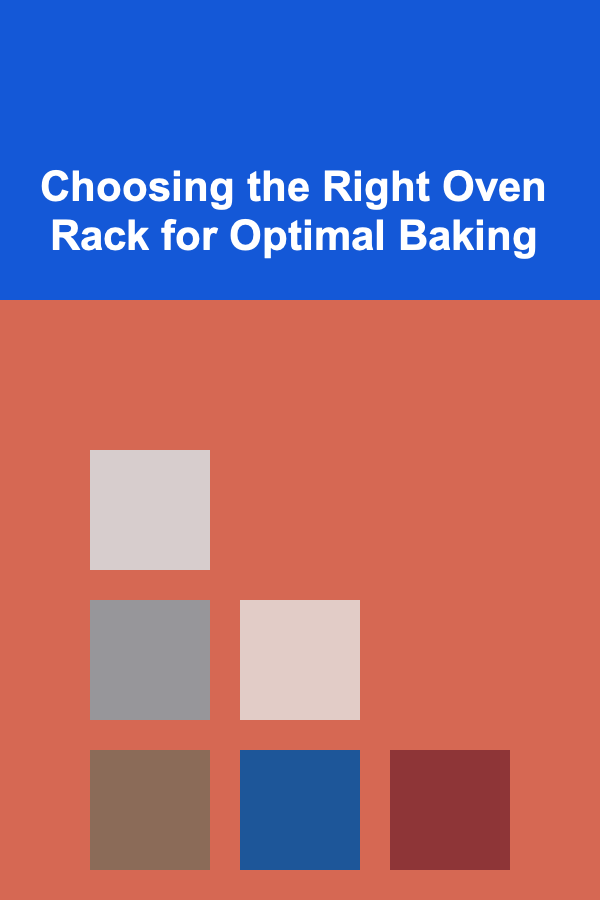
Choosing the Right Oven Rack for Optimal Baking
ebook include PDF & Audio bundle (Micro Guide)
$12.99$11.99
Limited Time Offer! Order within the next:

The seemingly simple act of placing an oven rack can have a profound impact on the success of your baking endeavors. While often overlooked, the position of the rack dictates the distribution of heat, ultimately influencing everything from the browning of a crust to the even cooking of a cake. Understanding the principles behind oven rack placement and how it affects different baked goods is crucial for achieving consistent and professional-quality results. This article delves into the nuances of oven rack positioning, exploring its effects on various types of baking and providing practical guidance for making informed choices.
Understanding Oven Heat and Rack Placement
Ovens operate by circulating hot air, but this circulation isn't uniform. Heat sources, typically located at the bottom or top of the oven, create temperature gradients. Knowing how your oven heats is the first step to mastering rack placement.
Heat Sources and Their Effects
- Bottom Element: Ovens with bottom heating elements tend to concentrate heat towards the bottom of the cavity. This is ideal for baking items where a crisp bottom crust is desired, such as pizzas or certain types of breads. However, it can also lead to burnt bottoms if not carefully managed.
- Top Element: The top element, often used for broiling, radiates intense heat downwards. While not typically used for baking (except for quick browning at the end of the process), understanding its presence is crucial for avoiding accidental burning of the tops of taller baked goods.
- Rear Element (Convection): Convection ovens utilize a fan to circulate hot air more evenly throughout the oven. This results in more consistent temperatures and faster cooking times. However, even in convection ovens, rack placement still matters, albeit to a lesser extent.
General Principles of Rack Placement
The general rule of thumb is to place the rack in the center position for most baking tasks. However, this is just a starting point. Consider these fundamental principles:
- Proximity to Heat: The closer the rack is to a heat source, the more direct heat the food receives. Lower racks are ideal for browning the bottom, while higher racks promote browning on top.
- Distance from the Top: Ensure sufficient space between the top of the food and the top heating element to prevent burning. Tall cakes, casseroles, or roasting poultry require a lower rack position.
- Air Circulation: Leave adequate space around the food for hot air to circulate freely. Overcrowding the oven or placing food too close to the walls can impede airflow and lead to uneven cooking.
Rack Placement Strategies for Specific Baked Goods
The ideal rack position varies depending on the specific item being baked. Here's a breakdown of recommended rack placements for common baked goods:
Cakes
For cakes, even heat distribution is paramount to ensure a level rise and consistent texture.
- Single Layer Cakes: Center rack position is generally recommended for single-layer cakes. This provides balanced heat from above and below, promoting even browning and preventing a sunken center.
- Two-Layer Cakes: When baking two cake layers simultaneously, using the middle and upper-middle rack positions is often best. Stagger the layers to allow for sufficient airflow. If your oven has hot spots, rotate the pans halfway through baking.
- Tall Cakes (e.g., Bundt Cakes): Place the rack in the lower third of the oven to prevent the top from browning too quickly before the inside is cooked through.
Cookies
Cookie baking often involves baking multiple sheets at once, requiring careful attention to rack placement.
- Single Sheet of Cookies: A center rack position is typically suitable for baking a single sheet of cookies. This ensures even browning on both the top and bottom.
- Multiple Sheets of Cookies: To bake multiple sheets of cookies simultaneously, use the upper-middle and lower-middle rack positions. Rotating the sheets halfway through baking is essential for achieving even browning and preventing some cookies from overcooking. Convection ovens are particularly helpful for baking multiple sheets of cookies, as they promote more uniform heat distribution.
Pies
Pie baking requires a balance of browning the crust and cooking the filling without burning either.
- Pies with Pre-Baked Crusts: For pies with pre-baked crusts, place the rack in the lower third of the oven to ensure the bottom crust is fully cooked and golden brown.
- Pies with Unbaked Crusts: Start with the rack in the lower third of the oven to encourage browning of the bottom crust. If the top crust starts to brown too quickly, cover it loosely with foil. You may need to move the pie to the center rack position towards the end of baking to ensure the filling is fully cooked.
Breads
Bread baking requires high heat to create a good crust and achieve a light, airy texture.
- Loaf Breads: Place the rack in the center position for loaf breads. This allows for even heat distribution, resulting in a well-risen loaf with a golden-brown crust.
- Artisan Breads (e.g., Sourdough): Often require a higher temperature and the use of a Dutch oven. Preheating the Dutch oven in the oven is crucial for achieving a crispy crust. The rack should be placed in the lower-middle position to allow for the intense heat to circulate around the Dutch oven.
- Pizzas: Place the rack in the lowest position for pizzas to achieve a crispy crust. Using a pizza stone or baking steel can further enhance the crispness of the crust.
Casseroles
Casseroles benefit from even cooking to ensure all ingredients are heated thoroughly.
- Casseroles: The center rack position is generally recommended for casseroles. This provides even heat distribution, ensuring that all ingredients are cooked through and the top is nicely browned. If the casserole is particularly tall, place the rack in the lower-middle position to prevent the top from burning.
Roasting Meats and Vegetables
Roasting benefits from proper airflow and sufficient distance from the top heating element.
- Roasting Meats: Place the rack in the lower third of the oven, especially for larger cuts of meat. This allows for even cooking and prevents the top from burning before the inside is cooked through. Using a roasting rack inside the pan elevates the meat, promoting better air circulation and more even browning.
- Roasting Vegetables: The center rack position is typically suitable for roasting vegetables. Toss the vegetables with oil and spread them out in a single layer on a baking sheet to ensure even browning.
Fine-Tuning Rack Placement: Addressing Common Baking Problems
Despite following general guidelines, baking results can vary due to oven quirks and individual preferences. Here are some troubleshooting tips related to rack placement:
Burnt Bottoms
If your baked goods consistently have burnt bottoms, try these solutions:
- Raise the Rack: Move the rack one or two positions higher.
- Use a Baking Sheet: Place a baking sheet on the rack below the food to deflect some of the heat.
- Lower Oven Temperature: Reduce the oven temperature by 25 degrees Fahrenheit.
- Check Oven Calibration: Ensure your oven is calibrated correctly. An inaccurate oven temperature can lead to burnt bottoms.
Burnt Tops
If the tops of your baked goods are burning before the inside is cooked, consider these adjustments:
- Lower the Rack: Move the rack one or two positions lower.
- Cover with Foil: Loosely cover the top of the food with foil to shield it from direct heat.
- Lower Oven Temperature: Reduce the oven temperature by 25 degrees Fahrenheit.
Uneven Baking
Uneven baking can be caused by hot spots in your oven or inadequate airflow. Here's how to address it:
- Rotate the Pans: Rotate the baking pans halfway through baking to ensure even exposure to heat.
- Check Oven Calibration: Ensure your oven is calibrated correctly.
- Ensure Adequate Airflow: Avoid overcrowding the oven or placing food too close to the walls.
- Use a Convection Oven (if available): Convection ovens promote more uniform heat distribution, reducing the likelihood of uneven baking.
Sunken Centers
A sunken center in a cake can indicate that the cake was not fully cooked in the middle. Here's how to prevent it:
- Use a Center Rack Position: Ensure the rack is in the center position for even heat distribution.
- Lower the Oven Temperature (Slightly): A slightly lower temperature allows the cake to cook more evenly.
- Check for Doneness: Use a toothpick or cake tester to check for doneness. It should come out clean or with a few moist crumbs.
Beyond Position: Other Factors Affecting Baking
While rack placement is crucial, it's important to remember that other factors also play a significant role in baking success:
Oven Temperature
An accurate oven temperature is essential for consistent baking results. Use an oven thermometer to verify the accuracy of your oven and calibrate it if necessary. Fluctuations in temperature can significantly impact baking times and outcomes.
Pan Material and Color
The material and color of your baking pans can affect how heat is absorbed and distributed. Dark-colored pans absorb more heat than light-colored pans, which can lead to darker crusts and potentially burnt bottoms. Glass pans also retain heat well. Adjust baking times and temperatures accordingly.
Recipe Accuracy
Following the recipe precisely is crucial for successful baking. Accurate measurements of ingredients are essential, as even slight deviations can alter the final product. Use measuring cups and spoons designed for baking, and level off dry ingredients carefully.
Ingredient Quality
The quality of your ingredients can also impact baking results. Fresh, high-quality ingredients generally yield better results. For example, using fresh baking powder or baking soda is essential for proper leavening.
Oven Preheating
Always preheat your oven to the specified temperature before baking. This ensures that the oven is at the correct temperature when the food is placed inside, promoting even cooking. Preheating allows the oven to reach a stable temperature, which is essential for consistent results.
Experimentation and Observation: The Key to Baking Mastery
Ultimately, the best way to master oven rack placement is through experimentation and careful observation. Every oven is different, and what works for one may not work for another. Keep a baking journal to record your rack placements, baking times, and the resulting outcomes. This will help you identify the optimal rack positions for different baked goods in your specific oven.
Don't be afraid to experiment with different rack positions and adjust your baking times as needed. Pay attention to the visual cues, such as the color of the crust and the evenness of browning. With practice and attention to detail, you'll develop a keen understanding of how rack placement affects your baking and achieve consistently delicious results.
Conclusion
Choosing the right oven rack position is a subtle but powerful tool in the baker's arsenal. By understanding the principles of heat distribution, considering the specific characteristics of each baked good, and carefully observing the results, you can fine-tune your oven technique and elevate your baking to new heights. Remember to consider all factors, from oven calibration to pan material, and embrace experimentation as you strive for baking perfection. The seemingly simple act of moving an oven rack can be the key to unlocking consistently delicious and beautifully baked creations.

How to Establish Clear Zones for Different Activities in Your Home
Read More
How to Organize Art Supplies and Toys Together
Read More
How to Set Up a Checklist for Preparing Your New CMS for Content Migration
Read More
What Should You Know About Organizing Your Smart Home Devices?
Read More
How to Create Animated Graphics (Basic Level)
Read More
How to Use Credit Cards for Online Shopping Safely
Read MoreOther Products

How to Establish Clear Zones for Different Activities in Your Home
Read More
How to Organize Art Supplies and Toys Together
Read More
How to Set Up a Checklist for Preparing Your New CMS for Content Migration
Read More
What Should You Know About Organizing Your Smart Home Devices?
Read More
How to Create Animated Graphics (Basic Level)
Read More